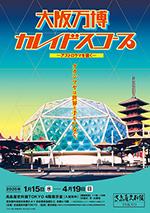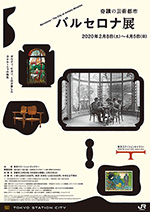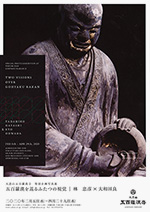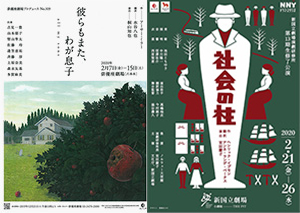 |
Picks is a monthly sampling of Japan's art scene, offering commentary by a variety of reviewers about exhibitions at museums and galleries in recent weeks, with an emphasis on contemporary art by young artists.
Note: Many museums in Japan are closed until further notice as a preventive measure against the spread of the coronavirus. Before visiting, please check with the museum. |
 |
 |
|
|
 |
 |
 |
 |
| Cosmic Garden by Sandra Cinto |
| 11 February - 10 May 2020 |
Ginza Maison Hermès
(Tokyo) |
 |
| One is first overwhelmed by the world of blue that covers the walls. Across it float white line drawings that evoke clouds, mist, sea-foam. Moving farther back into an even deeper blue space, one is surrounded by countless flickering stars. Cinto's imagined scenario is the worlds of the sky, the sea, and outer space. In the midst of fears of a worldwide pandemic, though, what it evoked for this reviewer was the ubiquity of the new virus. Cinto's stated concern is with the times when we humans confront our emotions as we deal with circumstances of catastrophe and chaos. Her work could not be more timely. |
|
|
 |
 |
 |
 |
 |
| Osaka Expo Kaleidoscope: Viewing the Astrorama |
| 15 January - 19 April 2020 |
Takashimaya Shiryokan Tokyo
(Tokyo) |
 |
| The venerable department store offers a look back at the Midorikan (Green Pavilion) that it co-sponsored at Osaka's Expo '70, half a century ago. The building itself was an impressive, bright-green geodesic dome, but the real highlight here is the exhibit about the Astrorama, a planetarium-like video presentation visitors could view inside. Written by Shuntaro Tanikawa with music by Toshiro Mayuzumi, the avant-garde work featured a gargantuan image of Butoh dancer Tatsumi Hijikata descending over the heads of the audience. |
|
|

|
 |
 |
|
 |
 |
 |
 |
 |
| Barcelona: The City of Artistic Miracles |
| 8 February - 5 April 2020 |
Tokyo Station Gallery
(Tokyo) |
 |
| Expecting the show would focus on Gaudi, as many that reference Barcelona do, I was happy to find that it is more about the city that gave birth to him. Topics range from the dramatic modernization and expansion of the city on a grid plan in the late 19th century, to the activities of architects during that period like Lluis Domenech I Montaner and Josep Jujol, who shared Gaudi's interest in ornamentation. Still, the most interesting section is about Barcelona's art milieu.
|
|
|
|
|
|
|
|

|
 |
 |
 |
 |
 |
 |
| Two Visual Perspectives of 500 Arhats: Tadashi Hayahiko x Ryo Owada |
| 5 February - 29 April 2020 |
Ten'on-zan Gohyaku Rakanji
(Tokyo) |
 |
| Ten'on-zan Gohyaku Rakanji temple in Meguro, Tokyo, is famed for its rows of wooden images of the enlightened disciples of the Buddha known as the 500 Arhats. The sculptor Genkei Shoun began carving them in 1691, completing over 500, of which 305 remain today. Entranced by the rich diversity of the facial expressions on these statues, Tadashi Hayahiko photographed all of them in 1982, bringing to bear his expertise in lighting and composition as a portrait photographer. In this exhibition at the temple, Hayahiko's works are paired with a more recent series shot by Ryo Owada in 2018. |
|
|
 |
 |
| Tomorrow is Today: Farming the Possible Fields |
| 25 February - 28 March 2020 |
Creation Gallery G8
(Tokyo) |
 |
| Showcasing the work of the Osaka-based design studio UMA / design farm, this exhibition was a revelation. Their work ranges from logos, posters, packaging, product planning, and book design to signage, pictograms, and the design and development of various kinds of public facilities. Unlike conventional art directors, their motto is "thinking together, making together" with their clients. Particularly impressive is the way the studio keeps one foot firmly in the graphic design field while it steps out into the arena of social design. |
|

|
 |
 |
 |
 |
 |
| Ozaki Shinpey: 1942020 |
| 18 February - 1 March 2020 |
Gallery Turnaround
(Miyagi) |
 |
| The show title is a conflation of 1942, the year of the cancelled Esposizione Universale Roma, and 2020, the year of the (now postponed) Tokyo Olympics. Of special interest is Ozaki's recurring motif, the Italian rationalist architecture promoted by Mussolini's fascist regime. Here the Palazzo della Civilta Italiana (now headquarters of the fashion house Fendi) is transformed into a love hotel. By placing rationalist architecture, an amalgam of modernism and classicism, in an entirely different context, Ozaki turns it into kitsch of the sort one might see by a suburban highway in Japan. |
|
|
 |
 |
 |
| All My Sons |
| 7 - 15 February 2020 |
| Haiyuza Theatre |
| The Pillars of Society |
| 21 - 26 February 2020 |
The National Theatre Tokyo
(Tokyo) |
 |
| Tomoya Kiriyama directed a Haiyuza production of Arthur Miller's famous 1946 play about business corruption and misplaced blame. Around the same time, Keiko Miyata directed a National Theatre production of Ibsen's similarly themed work from 1877, which takes place in a small Norwegian harbor town. Both works have aged all too well, resonating with contemporary events that pit the forces of social hypocrisy against the ideals of truth and freedom. |
|
|
|
|
|
|
|
|
|
 |
|